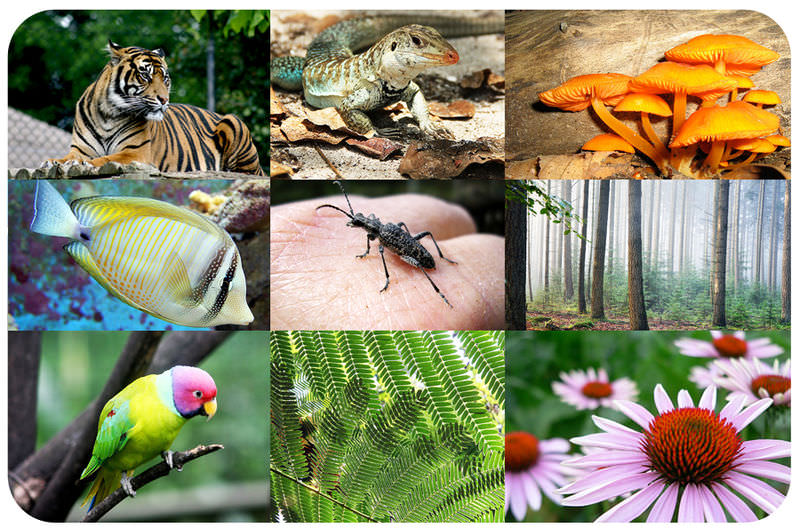6.16: Biodiversity
- Page ID
- 12143
\( \newcommand{\vecs}[1]{\overset { \scriptstyle \rightharpoonup} {\mathbf{#1}} } \)
\( \newcommand{\vecd}[1]{\overset{-\!-\!\rightharpoonup}{\vphantom{a}\smash {#1}}} \)
\( \newcommand{\dsum}{\displaystyle\sum\limits} \)
\( \newcommand{\dint}{\displaystyle\int\limits} \)
\( \newcommand{\dlim}{\displaystyle\lim\limits} \)
\( \newcommand{\id}{\mathrm{id}}\) \( \newcommand{\Span}{\mathrm{span}}\)
( \newcommand{\kernel}{\mathrm{null}\,}\) \( \newcommand{\range}{\mathrm{range}\,}\)
\( \newcommand{\RealPart}{\mathrm{Re}}\) \( \newcommand{\ImaginaryPart}{\mathrm{Im}}\)
\( \newcommand{\Argument}{\mathrm{Arg}}\) \( \newcommand{\norm}[1]{\| #1 \|}\)
\( \newcommand{\inner}[2]{\langle #1, #2 \rangle}\)
\( \newcommand{\Span}{\mathrm{span}}\)
\( \newcommand{\id}{\mathrm{id}}\)
\( \newcommand{\Span}{\mathrm{span}}\)
\( \newcommand{\kernel}{\mathrm{null}\,}\)
\( \newcommand{\range}{\mathrm{range}\,}\)
\( \newcommand{\RealPart}{\mathrm{Re}}\)
\( \newcommand{\ImaginaryPart}{\mathrm{Im}}\)
\( \newcommand{\Argument}{\mathrm{Arg}}\)
\( \newcommand{\norm}[1]{\| #1 \|}\)
\( \newcommand{\inner}[2]{\langle #1, #2 \rangle}\)
\( \newcommand{\Span}{\mathrm{span}}\) \( \newcommand{\AA}{\unicode[.8,0]{x212B}}\)
\( \newcommand{\vectorA}[1]{\vec{#1}} % arrow\)
\( \newcommand{\vectorAt}[1]{\vec{\text{#1}}} % arrow\)
\( \newcommand{\vectorB}[1]{\overset { \scriptstyle \rightharpoonup} {\mathbf{#1}} } \)
\( \newcommand{\vectorC}[1]{\textbf{#1}} \)
\( \newcommand{\vectorD}[1]{\overrightarrow{#1}} \)
\( \newcommand{\vectorDt}[1]{\overrightarrow{\text{#1}}} \)
\( \newcommand{\vectE}[1]{\overset{-\!-\!\rightharpoonup}{\vphantom{a}\smash{\mathbf {#1}}}} \)
\( \newcommand{\vecs}[1]{\overset { \scriptstyle \rightharpoonup} {\mathbf{#1}} } \)
\( \newcommand{\vecd}[1]{\overset{-\!-\!\rightharpoonup}{\vphantom{a}\smash {#1}}} \)
\(\newcommand{\avec}{\mathbf a}\) \(\newcommand{\bvec}{\mathbf b}\) \(\newcommand{\cvec}{\mathbf c}\) \(\newcommand{\dvec}{\mathbf d}\) \(\newcommand{\dtil}{\widetilde{\mathbf d}}\) \(\newcommand{\evec}{\mathbf e}\) \(\newcommand{\fvec}{\mathbf f}\) \(\newcommand{\nvec}{\mathbf n}\) \(\newcommand{\pvec}{\mathbf p}\) \(\newcommand{\qvec}{\mathbf q}\) \(\newcommand{\svec}{\mathbf s}\) \(\newcommand{\tvec}{\mathbf t}\) \(\newcommand{\uvec}{\mathbf u}\) \(\newcommand{\vvec}{\mathbf v}\) \(\newcommand{\wvec}{\mathbf w}\) \(\newcommand{\xvec}{\mathbf x}\) \(\newcommand{\yvec}{\mathbf y}\) \(\newcommand{\zvec}{\mathbf z}\) \(\newcommand{\rvec}{\mathbf r}\) \(\newcommand{\mvec}{\mathbf m}\) \(\newcommand{\zerovec}{\mathbf 0}\) \(\newcommand{\onevec}{\mathbf 1}\) \(\newcommand{\real}{\mathbb R}\) \(\newcommand{\twovec}[2]{\left[\begin{array}{r}#1 \\ #2 \end{array}\right]}\) \(\newcommand{\ctwovec}[2]{\left[\begin{array}{c}#1 \\ #2 \end{array}\right]}\) \(\newcommand{\threevec}[3]{\left[\begin{array}{r}#1 \\ #2 \\ #3 \end{array}\right]}\) \(\newcommand{\cthreevec}[3]{\left[\begin{array}{c}#1 \\ #2 \\ #3 \end{array}\right]}\) \(\newcommand{\fourvec}[4]{\left[\begin{array}{r}#1 \\ #2 \\ #3 \\ #4 \end{array}\right]}\) \(\newcommand{\cfourvec}[4]{\left[\begin{array}{c}#1 \\ #2 \\ #3 \\ #4 \end{array}\right]}\) \(\newcommand{\fivevec}[5]{\left[\begin{array}{r}#1 \\ #2 \\ #3 \\ #4 \\ #5 \\ \end{array}\right]}\) \(\newcommand{\cfivevec}[5]{\left[\begin{array}{c}#1 \\ #2 \\ #3 \\ #4 \\ #5 \\ \end{array}\right]}\) \(\newcommand{\mattwo}[4]{\left[\begin{array}{rr}#1 \amp #2 \\ #3 \amp #4 \\ \end{array}\right]}\) \(\newcommand{\laspan}[1]{\text{Span}\{#1\}}\) \(\newcommand{\bcal}{\cal B}\) \(\newcommand{\ccal}{\cal C}\) \(\newcommand{\scal}{\cal S}\) \(\newcommand{\wcal}{\cal W}\) \(\newcommand{\ecal}{\cal E}\) \(\newcommand{\coords}[2]{\left\{#1\right\}_{#2}}\) \(\newcommand{\gray}[1]{\color{gray}{#1}}\) \(\newcommand{\lgray}[1]{\color{lightgray}{#1}}\) \(\newcommand{\rank}{\operatorname{rank}}\) \(\newcommand{\row}{\text{Row}}\) \(\newcommand{\col}{\text{Col}}\) \(\renewcommand{\row}{\text{Row}}\) \(\newcommand{\nul}{\text{Nul}}\) \(\newcommand{\var}{\text{Var}}\) \(\newcommand{\corr}{\text{corr}}\) \(\newcommand{\len}[1]{\left|#1\right|}\) \(\newcommand{\bbar}{\overline{\bvec}}\) \(\newcommand{\bhat}{\widehat{\bvec}}\) \(\newcommand{\bperp}{\bvec^\perp}\) \(\newcommand{\xhat}{\widehat{\xvec}}\) \(\newcommand{\vhat}{\widehat{\vvec}}\) \(\newcommand{\uhat}{\widehat{\uvec}}\) \(\newcommand{\what}{\widehat{\wvec}}\) \(\newcommand{\Sighat}{\widehat{\Sigma}}\) \(\newcommand{\lt}{<}\) \(\newcommand{\gt}{>}\) \(\newcommand{\amp}{&}\) \(\definecolor{fillinmathshade}{gray}{0.9}\)
What is biodiversity?
How many species exist? We don't really know for sure. But all those species together, from the smallest bacteria, the deadliest protist, the most bizarre fungi, the prettiest plant, and the biggest mammal, compile the diversity of life, or biodiversity.
What Is Biodiversity?
Biodiversity refers to the variety of life and its processes, including the variety of living organisms, the genetic differences among them, and the communities and ecosystems in which they occur. Scientists have identified about 1.9 million species alive today. They are divided into the six kingdoms of life shown in Figure below. Scientists are still discovering new species. Thus, they do not know for sure how many species really exist today. Most estimates range from 5 to 30 million species.
 Known species represent only a fraction of all species that exist on Earth.
Known species represent only a fraction of all species that exist on Earth.Cogs and Wheels
“The first rule of intelligent tinkering is to save all the pieces.” --attributed to Aldo Leopold, but probably a shortened version of: “To save every cog and wheel is the first precaution of intelligent tinkering.” - Aldo Leopold, Round River: from the Journals of Aldo Leopold, 1953
What are the “cogs” and “wheels” of life?
Although the concept of biodiversity did not become a vital component of biology and political science until nearly 40 years after Aldo Leopold’s death in 1948, Leopold – often considered the father of modern ecology - would have likely found the term an appropriate description of his “cogs and wheels.” Literally, biodiversity is the many different kinds (diversity) of life (bio-). Biologists, however, always alert to levels of organization, have identified three measures of life’s variation. Species diversity best fits the literal translation: the number of different species in a particular ecosystem or on Earth. A second measure recognizes variation within a species: differences among individuals or populations make up genetic diversity. Finally, as Leopold clearly understood, the “cogs and wheels” include not only life but also the land, sea, and air that support life. Ecosystem diversity describes the many types of functional units formed by living communities interacting with their environments. Although all three levels of diversity are important, the term biodiversity usually refers to species diversity.
Science Friday: The Unlikely Tale of a Tenacious Snail
For over 70 years, no one had seen the oblong rocksnail. Declared extinct in 2000, the species was considered to be another native Alabaman mollusk gone and forgotten. But one day in the spring of 2011, biology grad student Nathan Whelan picked up a tiny rock and got a big surprise.
Further Reading
Importance of Biodiversity
Summary
- Biodiversity refers to the number of species in an ecosystem or the biosphere as a whole.
Review
- What is biodiversity?
- What are the three measures of life’s variations?
- What is meant by ecosystem diversity?
| Image | Reference | Attributions |
 |
[Figure 1] | Credit: Barbara Akre and Jin Yu, based on data from http://cnx.org/content/m12174/latest/ and en.Wikipedia.org/wiki/Biodiversity;Flower: User:Ulhaspa/Wikimedia Commons; Fish: J. Petersen; Car: CK-12 Foundation Source: CK-12 Foundation ; Flower: commons.wikimedia.org/wiki/File:Rosy_periwinkle.jpg ; Fish: commons.wikimedia.org/wiki/File:Ostracion_cubicus.JPG License: CC BY-NC; (Flower) CC BY 3.0; (Fish) CC BY 2.5; (Car) CC BY-NC 3.0 |
 |
[Figure 2] | Credit: Barbara Akre and Jin Yu, based on data from http://cnx.org/content/m12174/latest/ and en.Wikipedia.org/wiki/Biodiversity;Flower: User:Ulhaspa/Wikimedia Commons; Fish: J. Petersen; Car: CK-12 Foundation;Mariana Ruiz Villarreal (LadyofHats) for CK-12 Foundation Source: CK-12 Foundation ; Flower: commons.wikimedia.org/wiki/File:Rosy_periwinkle.jpg ; Fish: commons.wikimedia.org/wiki/File:Ostracion_cubicus.JPG License: CC BY-NC; (Flower) CC BY 3.0; (Fish) CC BY 2.5; (Car) CC BY-NC 3.0 |

